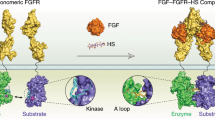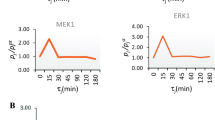Abstract
Fibroblast growth factors mediate cellular responses by interacting with a family of related receptor tyrosine kinases (FGFRs). We have previously shown that FGFR-1, but not of FGFR-4, ectopically expressed in BaF3 lymphoid cells allows for proliferation in response to FGFs, and that the intracellular signaling halves of these two receptors distinguish their mitogenic potentials (Wang et al., 1994). In order to map the residues which functionally distinguish these receptors, a panel of chimeric receptors whose cytodomains bear different contributions from FGFR-1 and FGFR-4 were constructed and characterized. The behavior of these chimeras implicate amino acids from both the kinase insert and kinase domains in receptor-mediated proliferation. Specifically, two tyrosine residues present in the short kinase insert domain of FGFR-1 and absent from FGFR-4 are a necessary, but not sufficient, component of a fully mitogenic receptor, suggesting that tyrosine phosphorylation in the kinase insert promotes a mitogenic signaling pathway. A strongly mitogenic receptor also requires one or two FGFR-1-specific residues from either of two regions within the kinase domain. One of these regions is within the kinase domain's activation loop, where FGFR-1, but not FGFR-4, bears a key aspartate residue. The mitogenic potentials of FGFR-1, FGFR-4, and the chimeric receptors strongly correlates with the magnitude of ligand-induced receptor autophosphorylation in BaF3 cells. We discuss mechanisms by which these few key amino acid differences may determine the levels of ligand-induced FGF receptor autophosphorylation and mitogenic potency.
This is a preview of subscription content, access via your institution
Access options
Subscribe to this journal
Receive 50 print issues and online access
$259.00 per year
only $5.18 per issue
Buy this article
- Purchase on Springer Link
- Instant access to full article PDF
Prices may be subject to local taxes which are calculated during checkout
Similar content being viewed by others
Author information
Authors and Affiliations
Rights and permissions
About this article
Cite this article
Wang, JK., Goldfarb, M. Amino acid residues which distinguish the mitogenic potentials of two FGF receptors. Oncogene 14, 1767–1778 (1997). https://doi.org/10.1038/sj.onc.1201021
Received:
Revised:
Accepted:
Issue Date:
DOI: https://doi.org/10.1038/sj.onc.1201021
Keywords
This article is cited by
-
Deficiency of metabolic regulator FGFR4 delays breast cancer progression through systemic and microenvironmental metabolic alterations
Cancer & Metabolism (2013)
-
Role of FGF-2/FGFR signaling pathway in cancer and its signification in breast cancer
Chinese Science Bulletin (2003)
-
The fibroblast growth factor receptor FGFR-4 acts as a ligand dependent modulator of erythroid cell proliferation
Oncogene (1999)



